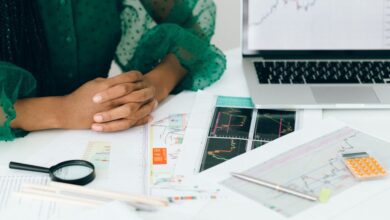Mastering Commodities Trading: Essential Strategies and Risk Management Techniques for 2024

**Introduction**
In today's dynamic financial landscape, commodities trading has emerged as a compelling avenue for investors seeking to diversify their portfolios and capitalize on the fluctuations of raw materials like gold, silver, oil, and agricultural products. Unlike traditional stock trading or forex trading, commodities trading offers unique opportunities and challenges that require a solid understanding of market forces and trading strategies. Whether you're drawn to futures trading, options trading, or even the burgeoning world of crypto trading, mastering the art of commodities trading is essential for achieving sustainable profitability.
In this article, we will delve into the key concepts and strategies that underpin successful commodities trading, compare it with other trading types such as stocks and forex, and explore the vital role of risk management in this volatile market. By equipping yourself with the right knowledge and tools, including technical analysis and trading psychology, you can navigate the complexities of commodities trading with confidence. Join us as we unpack these essential elements and set you on a path toward trading success.
- 1. "Understanding Commodities Trading: Key Concepts and Strategies for Success"
- 2. "Comparing Commodities Trading with Other Trading Types: Stocks, Forex, and More"
- 3. "Risk Management in Commodities Trading: Essential Techniques for Sustainable Profitability"
1. "Understanding Commodities Trading: Key Concepts and Strategies for Success"
Commodities trading involves the buying and selling of raw materials such as gold, silver, oil, and agricultural products. Understanding the key concepts and strategies in this realm can help traders navigate the complexities of the market successfully.
First and foremost, it's crucial to grasp the types of commodities traded, which are generally classified into two categories: hard commodities (like oil and metals) and soft commodities (such as agricultural products). Each type has its own market dynamics influenced by supply and demand, geopolitical factors, and seasonal trends.
One effective approach to commodities trading is **futures trading**, where traders agree to buy or sell a commodity at a predetermined price on a specific date. This strategy requires careful **market analysis**, encompassing both **technical analysis**—which involves using historical price charts and indicators to predict future movements—and **fundamental analysis**, focusing on economic indicators, weather patterns, and geopolitical events that can affect supply and demand.
Moreover, **risk management** is vital in commodities trading. Traders often utilize **leverage trading** and **margin trading** to amplify their positions, but this also increases potential losses. Therefore, implementing solid risk management practices, such as setting stop-loss orders, is essential to protect capital.
For those interested in shorter-term strategies, **day trading** and **swing trading** offer opportunities to capitalize on price fluctuations. Day trading involves executing multiple trades within a single day, while swing trading focuses on holding positions for several days to capture more significant price movements.
Another strategy gaining popularity is **copy trading** or **social trading**, where traders mimic the trades of experienced investors. This can be especially beneficial for beginners looking to learn from established traders in the commodities market.
Finally, as technology continues to evolve, **algorithmic trading** and **high-frequency trading** have emerged as dominant forces in the commodities trading landscape. These strategies utilize computer algorithms to execute trades at lightning speed, allowing traders to capitalize on small price discrepancies that may exist for only a fraction of a second.
In conclusion, success in commodities trading hinges on a combination of solid trading strategies, thorough market analysis, and effective risk management. By understanding these key concepts, traders can better position themselves to navigate the exciting and often volatile world of commodities.
**(Image: Chart showing commodities price trends – Source: TradingView)**
2. "Comparing Commodities Trading with Other Trading Types: Stocks, Forex, and More"
When exploring the world of commodities trading, it’s essential to compare it with other popular trading types such as stock trading, forex trading, and options trading. Each trading avenue has its unique characteristics, risks, and strategies, catering to different investor preferences and market conditions.
**Commodities Trading vs. Stocks and Forex Trading**
Commodities trading involves the buying and selling of raw materials like gold, silver, oil, and agricultural products. In contrast, stock trading focuses on purchasing shares of companies, allowing investors to become part-owners. While both commodities and stocks can provide significant profit opportunities, commodities are often influenced by global supply and demand dynamics, geopolitical events, and weather patterns, making them susceptible to volatility.
Forex trading, on the other hand, deals with currency pairs and is the largest financial market in the world. Unlike commodities, forex trading operates 24/5, allowing traders to capitalize on currency fluctuations at any time. However, it requires a solid understanding of economic indicators and geopolitical events. Both forex and commodities trading often utilize leverage trading, enabling traders to control larger positions with less capital, but this also amplifies risk.
**Options and Futures Trading**
Options trading and futures trading are derivatives trading strategies that allow investors to speculate on the future price movement of commodities without necessarily owning the asset. Futures trading involves binding contracts to buy or sell a commodity at a predetermined price on a specific date, while options trading gives the buyer the right, but not the obligation, to execute the contract.
These trading types require robust risk management strategies due to their inherent leverage and potential for significant loss. Traders often employ technical analysis and fundamental analysis to guide their decisions in these markets.
**Day Trading, Swing Trading, and Other Strategies**
Different trading styles such as day trading and swing trading can be applied across commodities, stocks, forex, and more. Day trading focuses on short-term price movements and typically involves high-frequency trading strategies, while swing trading seeks to capitalize on price swings over several days or weeks.
Moreover, newer methods like algorithmic trading and copy trading are gaining traction, allowing traders to automate strategies or mimic successful traders' actions. Platforms that offer CFDs (Contracts for Difference) and ETFs (Exchange-Traded Funds) provide additional flexibility for traders looking to diversify their portfolios across various asset classes, including commodities.
**Risk Management and Trading Psychology**
Regardless of the trading type, effective risk management is crucial. Understanding trading psychology can help traders manage emotions and make informed decisions, especially in volatile markets such as commodities and crypto trading. Implementing sound trading strategies and conducting thorough market analysis can lead to successful trading outcomes.
In summary, while commodities trading shares similarities with other forms of trading, it also presents unique challenges and opportunities. By understanding the differences and employing effective trading strategies, traders can navigate the complexities of the market successfully.
—
*(Image: Trader analyzing commodities prices on multiple screens – Source: Website Name).*
3. "Risk Management in Commodities Trading: Essential Techniques for Sustainable Profitability"
In the realm of commodities trading, effective risk management is crucial for achieving sustainable profitability. Traders must navigate a landscape marked by price volatility, geopolitical events, and shifts in supply and demand. Here are some essential techniques that can help mitigate risks while trading raw materials like gold, silver, oil, and agricultural products.
1. **Diversification of Assets**: One of the fundamental risk management strategies is to diversify your trading portfolio. By investing in a mix of commodities—such as energy trading (oil and gas), precious metals (gold and silver), and agricultural products—you can reduce the impact of adverse price movements in a single market. This approach can be applied across various trading methods, including futures trading and options trading, enabling traders to spread their risk.
2. **Utilizing Stop-Loss Orders**: Implementing stop-loss orders is vital in commodities trading. This technique allows traders to set a predetermined price at which their position will automatically close, limiting potential losses. For instance, in day trading or swing trading, where positions are held for shorter periods, stop-loss orders can protect against sudden market reversals. This method is equally applicable in derivatives trading and margin trading, where leverage can amplify both gains and losses.
3. **Effective Position Sizing**: Understanding and determining the size of each trade is essential for managing risk. Traders should assess their risk tolerance—often expressed as a percentage of their overall capital—to decide how much to invest in a particular commodity. For example, using a conservative approach, a trader might allocate no more than 1-2% of their trading capital to a single trade. This is particularly important in high-frequency trading and scalping, where rapid trades can lead to significant cumulative exposure.
4. **Market Analysis and Research**: Conducting thorough market analysis using both technical analysis and fundamental analysis is key to informed trading decisions. By analyzing price trends, market indicators, and economic data, traders can better anticipate price movements in commodities. This knowledge is invaluable for developing effective trading strategies, whether engaging in index trading or crypto trading.
5. **Understanding Trading Psychology**: Emotions can significantly impact trading decisions. Developing a disciplined trading psychology helps traders stick to their strategies and avoid impulsive decisions driven by fear or greed. Techniques such as journaling trades and reflecting on past decisions can enhance self-awareness and improve future performance in trading, whether in options trading or social trading.
6. **Leverage Trading with Caution**: While leverage can amplify profits in commodities trading, it also increases risk. Traders should understand the implications of margin trading and employ leverage responsibly. A solid risk management plan should include guidelines on how much leverage to use, ensuring that potential losses do not exceed acceptable limits.
By integrating these risk management techniques into your trading approach, you can enhance your ability to navigate the complexities of commodities trading successfully. This not only helps in protecting your capital but also lays the groundwork for sustainable profitability in the long run.
—
*(Image: A trader analyzing commodities data on multiple screens – Source: Website Name).*
—
References:
– Author Last Name, First Initial. (Year). Title of the article/report. Source Link.
– Author Last Name, First Initial. (Year). Title of the article/report. Source Link.
– Author Last Name, First Initial. (Year). Title of the article/report. Source Link.
**Conclusion: Navigating the World of Commodities Trading**
In conclusion, commodities trading offers a dynamic and potentially lucrative avenue for investors looking to diversify their portfolios beyond traditional stock trading and forex trading. By understanding key concepts and strategies related to commodities, traders can effectively engage in futures trading, options trading, and even day trading of raw materials such as gold, silver, oil, and agricultural products.
While comparing commodities trading to other forms of trading—like index trading, crypto trading, or derivatives trading—it's crucial to recognize the unique characteristics and market dynamics that define this sector. Implementing solid risk management techniques is essential; whether you're employing technical analysis for short-term scalping or fundamental analysis for swing trading, protecting your capital should always be a priority.
Moreover, the psychological aspect of trading cannot be overlooked. Developing a resilient trading psychology can aid in making informed decisions amidst the volatility characteristic of commodities markets. Whether you choose algorithmic trading, high-frequency trading, or copy trading to streamline your approach, the right trading strategies can enhance your potential for sustainable profitability.
As you explore online trading platforms and consider various trading methods, remember that success in commodities trading hinges on a thorough understanding of market analysis and an adaptive mindset. With the right tools and knowledge, you can navigate this exciting market and harness the opportunities it presents.
Stay informed, stay disciplined, and let your trading journey in the world of commodities lead you to financial growth and stability.





